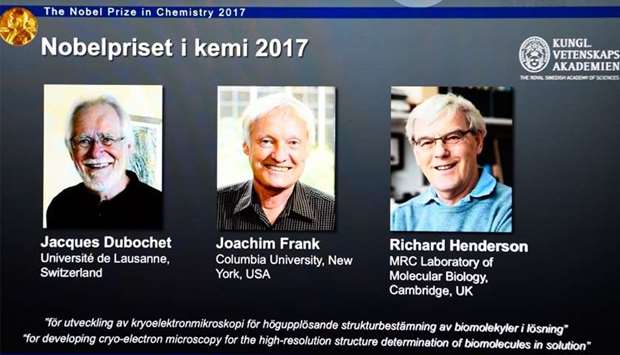Cryo-electron microscopy - ‘a cool method for imaging the molecules of life’ - earned a trio of researchers the 2017 Chemistry Nobel prize on Wednesday, announced the Royal Swedish Academy of Sciences.
The award goes to: Jacques Dubochet, 75, a Swiss national who is honourary professor of biophysics at the University of Lausanne; Briton Richard Henderson, 72, who was born in Scotland and is now programme Leader at MRC labouratory of Molecular Biology, in Cambridge; and Joachim Frank, 77, an American born in Germany, who is currently professor of biochemistry and molecular sciences at Columbia University in New York.
The technology for which they won provides detailed imagery of biomolecules invisible to the human eye and allows researchers to study them in unprecedented detail - at the atomic-structural level. It has crucial uses, amongst other things, for the development of pharmaceuticals.
‘Biochemical maps have long been filled with blank spaces because the available technology has had difficulty generating images of much of life's molecular machinery. Cryo-electron microscopy changes all of this,’ acknowledged a Nobel Prize Committee press statement.
‘We are facing a revolution in biochemistry,’ said Sara Snogerup Linse, the chairperson of the Nobel Committee that helps pick the Nobel laureates in chemistry.
Cryo-electron microscopy was recently used to study the biomolecules linked to the Zika virus, which is responsible for cases of extremely small heads in newborn babies in Brazil and several other Latin American nations.
Each scientist made a distinct contribution to the development of cryo-electron microscopy, which from 2013 has been able to deliver high-resolution pictures in atomic resolution.
Frank said he was ‘fully overwhelmed’ on learning that he was a winner.
‘I thought the chances of winning a Nobel prize were miniscule, there are so many other innovations and discoveries,’ he said, speaking by phone to reporters at the Royal Swedish Academy of Sciences.
The chemistry prize was the third of this year's Nobel Prize awards to be announced.
Last year, the chemistry prize was awarded Jean-Pierre Sauvage, Sir J Fraser Stoddart and Bernard L Feringa, who figured out how to mechanically link molecules to make the world's smallest motors and machines.
The Nobel award week opened Monday with a trio of US scientists sharing the Nobel Prize in Physiology or Medicine for research into how organism's internal biological clocks align themselves with natural cycles of night and day.
On Tuesday, three American researchers shared the Nobel Prize in Physics for contributed to proving the existence of gravitational waves, confirming a century-old theory by Albert Einstein.
Recipients of prizes in the fields of literature and peace will be announced later this week. The economics award is due next week.
With the exception of economics, the prizes were endowed by Swedish industrialist Alfred Nobel (1833-96), the inventor of dynamite. This year the prizes are worth 9 million kronor (1.1 million dollars).



